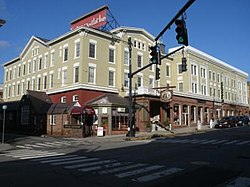| Municipalities of Connecticut | |
|---|---|
 Towns (light grey) and cities (dark grey) of Connecticut | |
| Location | State of Connecticut |
| Number | 169 |
| Populations | 785 (Union) – 148,654 (Bridgeport) |
| Areas | 4.98 square miles (12.9 km2) (Derby) – 61.59 square miles (159.5 km2) (New Milford) |
| Government | |
The U.S. state of Connecticut is divided into 169 municipalities, including 19 cities, 149 towns and one borough, which are grouped into eight historical counties, as well as nine planning regions which serve as county equivalents.
Contents
- List of municipalities in Connecticut
- Cities
- Former cities
- Gallery
- Boroughs
- See also
- Notes
- References
- External links
Towns traditionally have a town meeting form of government; under the Home Rule Act, however, towns are free to choose their own government structure. Nineteen of the towns in Connecticut are consolidated city-towns, and one (Naugatuck) is a consolidated borough-town.
City incorporation requires a Special Act by the Connecticut General Assembly. All cities in Connecticut are dependent municipalities, meaning they are located within and subordinate to a town. However, except for one, all currently existing cities in Connecticut are consolidated with their parent town. Former inner-cities are listed in a separate table below.
Towns in Connecticut are allowed to adopt a city form of government without the need to re-incorporate as an inner-city. Connecticut state law also makes no distinction between a consolidated town/city and a regular town. Bolded city names indicate the state's largest cities, with the most populated being Bridgeport. Currently, Tolland County and Windham County are the only counties in Connecticut without a single city in them.




















